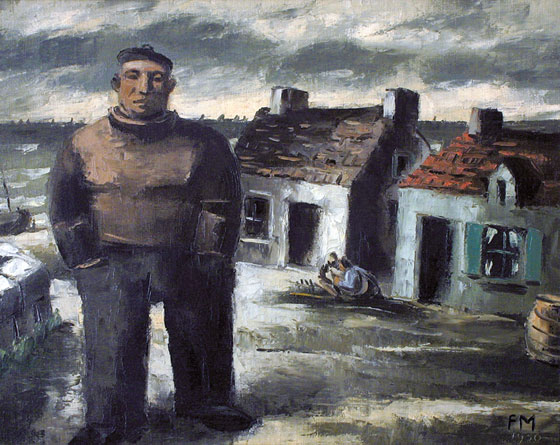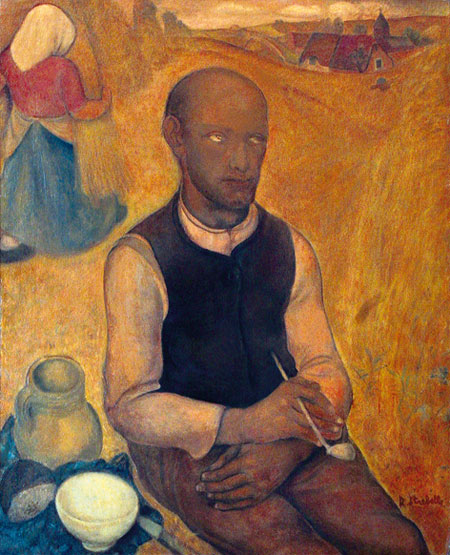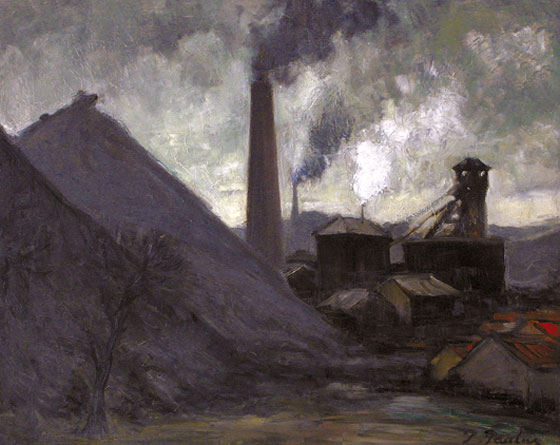|
|
| Belgian art. Collection of the Museum of foreign art Daiga Upeniece Daiga Upeniece, Director of the Museum of Foreign Art Dorine Cardyn-Oomen, Scientific director of Kooinklijk Museum voor Schone Kunsten Antwerpen Conversation before the exhibition opening. | |
 Frans Masareel. Sailor. 1930 | |
| Daiga: On June 5, the exhibition of the 20th century Belgian art was opened at the Museum of Foreign Art; this is a part of the wide art collection received by the Latvian State as a gift in the 30s of the 20th century. It is traditionally esteemed as one of the most valuable parts of the museum funds, and such attitude was inherited in the course of generations. Equally traditionally, the same works are presented as a visiting card of the whole collection. If we start to contemplate why it is so and not otherwise, the answer can be found in the Belgian art collection catalogue, made in the 1930s, and in which works of individual authors are marked out as a particular value. It should be admitted that probably we have retained our understanding of the 1930s, which were possibly unique for Belgium - the country where this is their national art. However, we know quite well that coming generations are in the habit of replacing the accents, because contemporaries may be affected by charm of some charismatic individuality, who is probably not so outstanding as artist, but who is a favourite of the public. How would you comment upon accuracy of this catalogue of the 1930s compared to the understanding of today, and is the existence of this collection a surprise for you? Dorine: The existence of the Belgian art collection in Riga was a surprise for me. I knew some of the works in this collection, e.g. the ‘Portrait of Painter Anto Carte' by Louis Buisseret, which is illustrated in some recent exhibition catalogues. But I had no idea that this painting was just one of the many interesting works of early 20th century Belgian art in Riga. Unfortunately, I am not familiar with the Belgian art collection catalogue which was made in the 1930s. So, it is difficult to compare the accuracy of that catalogue to the understanding of today. Daiga: Are there any authors' works, which could be regarded as a special success and value of this collection? Dorine: There are, of course, many interesting paintings, sculptures, drawings and prints illustrating the influence of the artistic innovations of that time, as I explained in my article ‘Some Aspects of Belgian Art in the First Decades of the 20th Century' in the exhibition catalogue. The Nervia group is represented in this collection very well. For instance, the paintings of Louis Buisseret and Anto Carte, both founders of Nervia in 1928, are very beautiful examples of their serene art with the attention for balanced composition, pure colours and outspoken contours. Daiga: The Antwerp Art Museum has a marvelous art collection of this period - the early 20th century. Has it once been purchased as contemporary art, or was it stored up in the following years? Do you see any work from the collection of our museum, which you would like to see in the exposition of your museum? Dorine: Several aspects of Belgian art in the early 20th century are represented very well in the collections of the Royal Museum of Fine Arts in Antwerp. There is a unique collection of Rik Wouters, the Brabant Fauvist. The Symbolist artists who withdrew around 1900 to the village of Sint-Martens-Latem are represented with typical paintings and sculptures, as well as Jakob Smits and Eugene Laermans, who were searching for an individual approach towards a pictorial synthesis, and of course the Flemish Expressionists who were very active and dominant in the 1920s. Quite a lot of those works were acquired when the artists were still alive, but after the 2nd World War this important collection of early 20th century art in Belgium was extended with more important works. | |
 Rodolphe Strebelle. Peasant of Brabant. Undated | |
| Daiga: As we began our conversation talking about purchases and gifts, I would like to dwell upon this issue. The Riga collection was created thanks to one of the most prominent Latvian diplomats of the 1930s - Mr. Jānis Lazdiņš, the Ambassador of Latvia in Belgium. It was due to his initiative to create this collection and due to his original individuality that this idea received such a great support. I think that 53 paintings, 9 sculptures, 111 drawings and 344 medals present a capacious gift. Mr. Lazdiņš' enthusiasm removed the boundary of distinction between art and diplomacy through creation of an art collection within the diplomatic surroundings. Do you think this is an unprecedented event or a regularity? Dorine: In the late 1920s the Belgian government organised several large exhibitions of contemporary Belgian art in major cities in other countries, e.g. in Stockholm and in Riga. But it was thanks to the initiative, the enthusiasm and also the cultural interest of Mr. Jānis Lazdiņš that it became possible to bring so many interesting works of art together and to enrich the museum in Riga with this collection. The way through which this collection of Belgian art was acquired by the museum of Riga is very remarkable, and the gift of such a large collection of contemporary art by one person is certainly rather unusual. Daiga: A gift created spontaneously and dictated largely by the authors' choice is always inherent of a risk - whether the best will be donated or maybe there were problems with selling the artworks and the donation was a solution. Another factor strongly influencing the rate of the collection comprising works of some particular, quite limited period, is the question about the authors who have been addressed - whether they are adherents of classical values and followers of traditions of the previous generations, or breakers of new paths and adherents of Modernism. It seems that Mr. Lazdiņš never deliberately put any bounds when creating the collection, that embodies a realistic picture of the epoch and where several generations with quite different world perception are represented in the widest spectrum. He certainly never missed an opportunity if some work of art was offered for his personal choice. But this was after all the only way of attempting to keep some order or balance. As we periodically open exhibitions of Belgian art where the works from Lazdiņš' collection are included, we always have a dilemma - whether to select the best artworks or to show the collection in its entirety? In what way do you think this problem could be solved? As our conversation takes place in Riga, I would be happy to learn from you, to what extent was it interesting for you to watch the Latvian art of the 1930s at the Latvian National Museum of Art, and did you feel any impact on the works of some authors left by the wide exhibition of Belgian contemporary art at the Riga City Art Museum or by the above mentioned collection of Belgian art displayed at the State Museum of Art at that time? Dorine: It is clear that Mr. Jānis Lazdiņš had good contacts with Belgian artists, and he obviously could persuade them to donate typical and representative works. A collection assembled by one person - in this case Mr. Jānis Lazdiņš - always tells a lot about the taste of this person. In this specific case the accent is put not on the avant-garde art, but on the works of artists who had taken a rather moderate position but whose works reflected also the influence of changes in form and content. It would be interesting to see the whole of Lazdiņš' collection in a publication where every painting, drawing, print and sculpture is not only described but also illustrated. But for exhibitions it is probably more relevant to show selections, eventually in confrontation with other works of art. It was quite interesting to see the collection of Latvian art of the 1930s at the Latvian National Museum of Art, and I am sure that confrontation between works of the Belgian collection and works of some Latvian artists, who obviously knew this Belgian art collection, and some of them had other contacts with the art world of Western Europe, would be interesting. | |
 Pierre Paulus. Coalmine. Undated | |
|
Daiga: Thank you for visiting Riga and the opening of the exhibition of Belgian art that has already been brought to evaluation of the public. The catalogue of Belgian art created by our common efforts is also available for those interested. Thus, the project has already begun its own life. What is your opinion - would the Antwerp Art Museum have an interest to make some collaborative project bearing the name of Riga in future? Dorine: This exhibition and catalogue is a very interesting project. Thanks to this initiative the collection is no longer known only to a small group of people but it is made accessible to wide audience. | |
| go back | |







